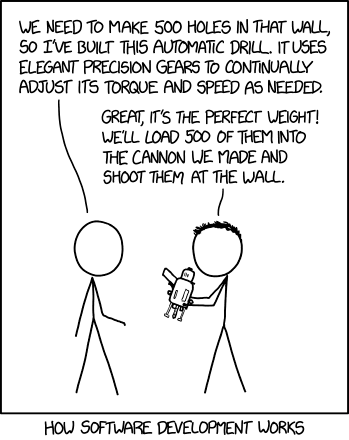
Source: XKCD #2021 by Randall Munroe
Internal Quality
With Internal software quality, we are concerned with the software quality from the perspective of the developers. The primary measure of Internal Quality is Maintainability. That is, the internal quality of software is how maintainable it is from the developers.
Contents
Software Maintenance
Maintenance in this context relates to anything from the evolution of software over initial development, bug fixes, new features, changing features, etc. We can break maintainability down into:
- Analyzability - to what extent can the software construction be understood?
- Changeability - the effort it requires to makes changes to the software
- Stability - the extent to which changes in one part of a software construction affect other parts
- Reusability - the extent to which parts of the construction can be reused in other parts of the construction or in other software projects.
- Testability - the extent to which the software can be tested to find faults or defects in the software construction
The key to internal quality
In this class we will spend a lot of time focusing on internal software quality:
- We will improve the analyzability of our software by writing clean code and using decomposition to make each portion of our code more modular.
- We will use version control software to ensure our software is changeable, and follow good design principles to ensure our code is receptive to change.
- We will use the principles of modularity and design patterns to decouple unrelated portions of our system, increasing stability.
- We will use object-orientation to improve and refactoring to improve the reusability of our code.
- We will use JUnit and Test Driven Development to ensure our software is not only testable, but thoroughly tested.
And the most important skill to achieving high internal software quality is design. We need to design our software in a way to make it maintainable. We cannot add maintainability after the fact! We have to use good practice to ensure our software stays maintainable.
Software Entropy
Entropy is the idea that in our Universe, energy within a closed-system cannot become more orderly overtime, and not all processes are reversible. That is, things trend towards disorder. A consequence of this is that the chemical energy in gasoline cannot be perfectly turned into kinetic energy. We will lose some energy to heat and sound energy, and it is impossible to turn all that back into chemical energy without needing even more energy. Ultimately, given enough time, even our observable universe itself will no longer produce stars, as all energy becomes so spread out as to never meaningfully interact again.
In the same way, overtime, software naturally becomes harder and harder to modify. The maintainability of the software decreases. This is party because the software becomes larger and more complex; the more code there is, the longer it takes to understand. This is also partly because of bad design or haphazard changes, leading to things like Spaghetti code, where changing code in one system produces unexpected results in seemingly unrelated systems.
Even relatively small applications can fall prey to software entropy. Think back to homework you’ve done in the past. How many times have you tried to fix a bug, thought it was a simple “one line fix”, only to realize changing that one line broke other parts of the program?
A common parody of the children’s song “99 Bottles of Beer on the Wall” may go something like:
“99 unfixed bugs in the code
99 unfixed bugs
You take one down, patch it around
105 unfixed bugs in the code”
For some software, this song never ends: we never fix all the known defects (let alone unknown defects), because doing so would require more effort than it is worth. If a bug only occursin exceedingly rare cases, is hard to recreate, and fixing would require a massive redesign of several highly connected sub-systems, we often may not fix it at all.
But that’s bad! If we’re at this point, we’ve already had a design and development failure! Ultimately, we can never create a perfect design that will always ensure are software stays maintainable forever. But a good design can dramatically slow down entropy, whereas a bad design guarantees entropy is going to be nearly instantaneous (for example: write a large application entirely in a single main function or class).